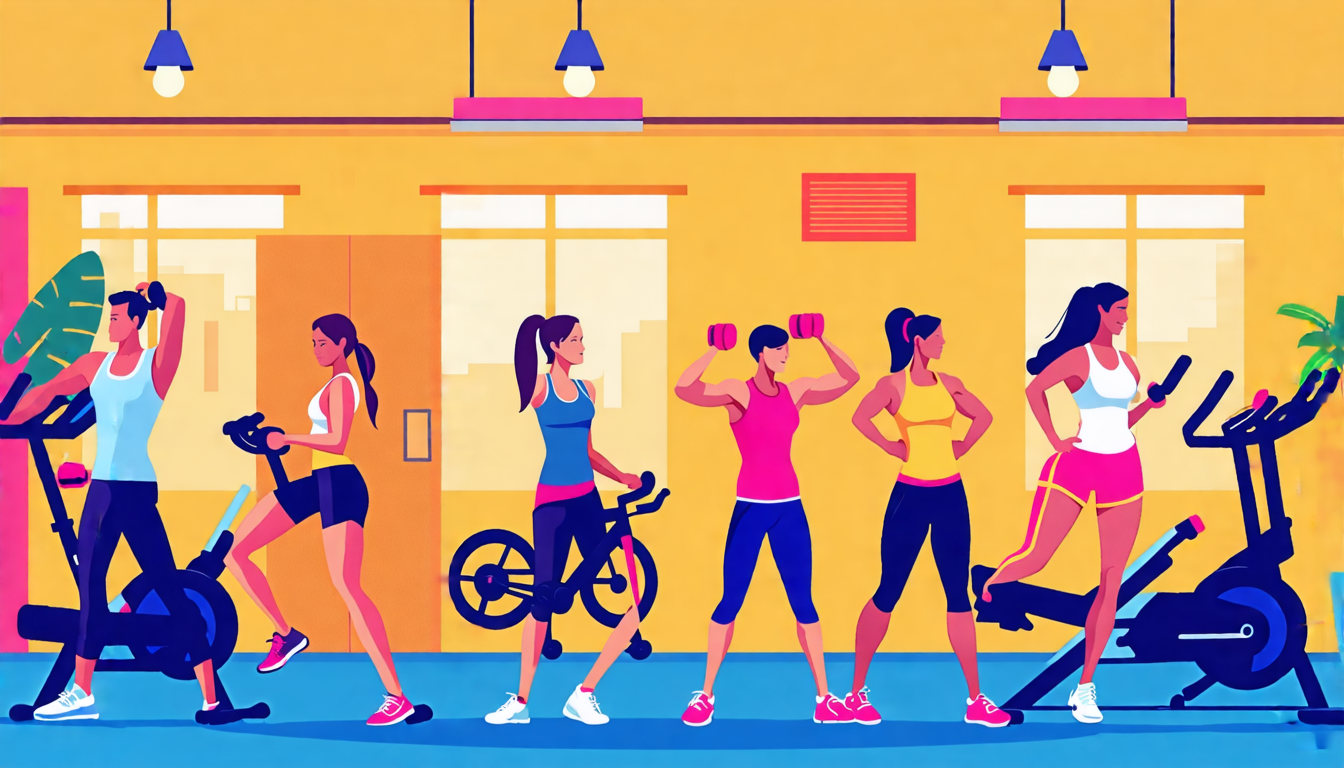Achieving your fitness goals requires more than just dedication and effort; it entails understanding and respecting your body’s unique needs and capabilities. This is where the concept of adapting to fitness levels comes into play. Recognizing the importance of personalized fitness is essential for anyone, whether you’re just starting your journey or you’re a seasoned athlete looking to elevate your performance. A tailored approach not only optimizes results but also minimizes the risk of injury, ensuring that your fitness regime contributes positively to your overall well-being.
Assessing your current fitness level is the first step towards creating a workout plan that works for you. Utilizing a variety of tools and methods, such as fitness assessments, measurement tools, and even professional evaluations, can provide valuable insights into your strengths and areas for improvement. By understanding where you stand, you can set realistic goals and design a fitness program that is both effective and sustainable.
Adapting workout routines to your fitness level involves creating plans that cater to different stages of fitness: beginner, intermediate, and advanced. Each level has its own set of challenges and milestones, and it’s crucial to recognize these to maintain progress and prevent burnout. Customizing exercises, learning to scale workouts, and understanding how to modify routines to match your abilities can significantly enhance your fitness journey. Regardless of where you start, the key is consistent, progressive challenges that keep you motivated and moving forward. By embracing a personalized approach to fitness, you pave the way for long-term success and a healthier, more active lifestyle.
Understanding Individual Fitness Levels
Recognizing the Importance of Personalized Fitness
When it comes to fitness, one size does not fit all. Every individual possesses unique physical characteristics, strengths, and limitations that necessitate a personalized approach to exercise. Personalized fitness is paramount because it ensures that workouts are safe, effective, and enjoyable. Ignoring your specific fitness level can lead to injuries, burnout, or a lack of motivation, which ultimately hampers progress.
Personalized fitness recognizes the diversity in fitness backgrounds, goals, and potential barriers. For instance, an exercise plan for someone recovering from an injury will vastly differ from one designed for an athlete preparing for competition. Tailor-made routines consider various factors like age, weight, medical history, and fitness objectives, promoting a balanced progression rather than a cookie-cutter approach.
Furthermore, personalized fitness plans are crucial for consistency. When workouts align with an individual’s abilities and interests, they are more likely to stick with their routine. This consistency builds a foundation for long-term success, helping individuals make sustainable changes to their health and well-being.
Assessing Your Current Fitness Level: Tools and Methods
Evaluating your current fitness level is the first step towards crafting a personalized fitness plan. There are numerous tools and methods available to help you determine where you stand. Understanding your baseline fitness level can provide insights into strengths and areas that need improvement, guiding your exercise journey effectively.
1. Body Composition Analysis
Body composition analysis measures the proportion of fat and non-fat mass in your body. Traditional methods include Body Mass Index (BMI), skinfold measurements, and bioelectrical impedance analysis (BIA). These metrics offer insights into your overall health and can help tailor your exercise regime to either lose fat, gain muscle, or maintain a healthy balance.
2. Cardiovascular Endurance Tests
Cardiovascular endurance determines how efficiently your heart and lungs can supply oxygen to your muscles during sustained physical activity. Common tests include the treadmill stress test, the Cooper 12-minute run, or the step test. These methods gauge how well your cardiovascular system performs and can indicate whether you need more cardio-focused workouts.
3. Muscular Strength and Endurance Assessments
Muscular strength assessments typically involve lifting weights to measure the maximum amount of force you can exert. Exercises such as the bench press, squat, or deadlift are often used. Muscular endurance, on the other hand, tests how long your muscles can endure an exercise, such as the number of push-ups or sit-ups performed in one minute. These assessments help identify your capacity to perform strength-based activities and guide you in selecting appropriate resistance training options.
4. Flexibility Tests
Flexibility assessments measure the range of motion around your joints, which is crucial for overall mobility and injury prevention. Common tests include the sit-and-reach test or shoulder flexibility test. Knowing your flexibility levels can help you incorporate the right stretching or yoga exercises to enhance your overall fitness routine.
5. Functional Movement Screen (FMS)
The Functional Movement Screen (FMS) evaluates seven fundamental movement patterns to identify muscle imbalances and movement deficiencies. This screen can highlight areas needing attention to prevent injury and enhance efficiency in movement. It’s a valuable tool for creating a comprehensive, personalized fitness plan that addresses these weaknesses.
By leveraging these tools and methods, you can obtain a holistic understanding of your current fitness level. This, in turn, allows for a customized approach tailored specifically to your needs, ensuring a balanced, effective, and sustainable fitness journey.

How to Adapt Workout Routines to Your Fitness Level
Beginner, Intermediate, and Advanced Workout Plans
When it comes to adapting workout routines, it is crucial to recognize that one-size-fits-all approaches rarely work. Customizing your workout plan according to your fitness level ensures that you are challenging your body appropriately while minimizing the risk of injury. Below, we break down the workout plans for beginners, intermediate, and advanced fitness enthusiasts.
Beginner Workout Plan
For those just starting out, the focus should be on building a solid foundation. The beginner workout plan typically emphasizes fundamental exercises, proper form, and consistency. Here’s a sample beginner workout routine:
- Warm-Up: 5-10 minutes of light cardio (e.g., brisk walking, cycling).
- Bodyweight Squats: 3 sets of 10-15 reps.
- Push-Ups: 3 sets of 5-10 reps (can be modified to knee push-ups if necessary).
- Plank: Hold for 20-30 seconds, 3 repetitions.
- Walking Lunges: 3 sets of 10-12 reps per leg.
- Cool-Down: 5 minutes of stretching focusing on major muscle groups.
Beginners should aim to perform this workout routine 2-3 times a week, gradually increasing intensity and reps as they build strength and endurance.
Intermediate Workout Plan
Individuals who have a few months of consistent training under their belt may consider themselves intermediate. The intermediate workout plan aims to incorporate more complex movements and increased intensity. Here’s an example routine:
- Warm-Up: 5-10 minutes of dynamic stretches and light cardio.
- Dumbbell Bench Press: 3 sets of 8-12 reps.
- Goblet Squats: 3 sets of 10-15 reps.
- Seated Rows: 3 sets of 10-12 reps.
- Romanian Deadlifts: 3 sets of 10-12 reps.
- Bicycle Crunches: 3 sets of 15-20 reps.
- Cool-Down: 5-10 minutes of stretching.
Intermediate trainees should aim for this routine 3-4 times a week. Variations can also include incorporating compound exercises and tweaking volume and intensity for continued progress.
Advanced Workout Plan
Advanced fitness enthusiasts require a more challenging and diverse exercise routine to continue progressing. An advanced workout plan often includes higher intensity workouts, plyometrics, and compound lifts. Here’s a sample advanced workout routine:
- Warm-Up: 10 minutes of dynamic stretches and foam rolling.
- Barbell Back Squats: 4 sets of 8-10 reps.
- Pull-Ups: 4 sets of 6-10 reps.
- Deadlifts: 4 sets of 8-10 reps.
- Bench Press: 4 sets of 6-8 reps.
- Hanging Leg Raises: 4 sets of 12-15 reps.
- Cool-Down: 10 minutes of thorough stretching and mobility work.
Advanced individuals should aim to hit the gym 4-5 times per week and take into account the importance of proper recovery strategies, such as incorporating active rest days and monitoring for signs of overtraining.
Tips for Scaling and Modifying Exercises
Regardless of your fitness level, there may be times when scaling or modifying exercises becomes necessary. Whether it’s due to physical limitations, recovering from injury, or simply the need to progress slowly, the following tips can help you tailor your exercises effectively:
Start with Lighter Weights and Progress Gradually
Using lighter weights allows you to focus on mastering the form first. Once you are comfortable, incrementally increase the load. This approach is especially important for beginners but also useful for those returning to exercise after a break.
Alter the Range of Motion
Modifying the range of motion can make an exercise easier or more challenging. For example, if full push-ups are too strenuous, start with knee push-ups or push-ups against a wall. As you build strength, work your way up to partial and then full push-ups.
Use Supportive Equipment
Resistance bands, workout benches, and stability balls can assist in making exercises more accessible or adding an extra layer of challenge. For example, using resistance bands can provide support during pull-ups or add resistance to bodyweight squats.
Break Reps into Smaller Sets
If the prescribed reps are too much to handle at once, break them down into smaller, more manageable sets. Instead of doing 15 reps in a single set, you could do 3 sets of 5 reps with short breaks in between.
Incorporate Rest Days Wisely
Listening to your body and incorporating adequate rest days is essential for recovery and optimal performance. Ensure that your workout schedule includes rest or low-intensity days, particularly if you are feeling fatigued or sore. This is crucial for all fitness levels.
Adjust Tempo and Intensity
Slowing down the tempo of each rep can increase the difficulty and provide a greater challenge without the need to increase weight. Conversely, speeding up certain exercises can add a cardiovascular element. Modify the intensity based on how your body feels.
Stay Tuned to Your Body’s Feedback
Above all, paying attention to your body’s feedback is imperative. Sharp pain, extreme fatigue, or significant discomfort are signs that may indicate the need to scale back. Adjust your workout plan accordingly to avoid injury and promote long-term adherence to your fitness regimen.
Incorporating these tips for scaling and modifying exercises ensures that your fitness journey is safer, more effective, and tailored to your individual needs. Whether you’re starting from scratch, advancing your fitness routine, or anywhere in between, the ability to adapt your exercises is central to achieving your fitness goals.
In conclusion, adapting to individual fitness levels is crucial for achieving optimal health and wellness through exercise. Recognizing the importance of personalized fitness allows each person to maximize their efforts, while also reducing the risk of injury and burnout. Assessing your current fitness level using various tools and methods provides a clear starting point from which to build an effective and sustainable workout regimen.
By understanding where you stand, you can make informed decisions about the types of exercises and intensity levels that are most appropriate for you. Tailored workout plans for beginners, intermediates, and advanced fitness enthusiasts ensure that everyone can participate in a fitness routine that is both challenging and achievable.
Moreover, the ability to scale and modify exercises according to your progress is essential. This not only helps maintain motivation but also ensures continuous improvement by progressively increasing the complexity and intensity of workouts as your fitness level advances. Embracing a personalized approach to fitness not only makes exercise more enjoyable but also promotes long-term engagement and success in your fitness journey.
Ultimately, the key to a successful fitness regimen lies in understanding your unique needs and adapting your workout routines accordingly. By doing so, you establish a positive and productive relationship with exercise that can lead to enduring health benefits and a higher quality of life.

